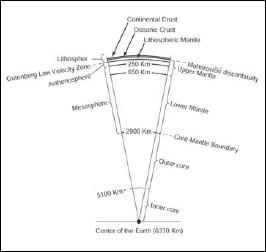EarthPhysical Characteristics |
What is the interior of the earth like? |
The earth is divided into a number of layers. The topmost layer is the crust, which contains about 0.6 percent of the earth’s volume. The depth of the crust varies from 3.5 to 5 miles (5 to 9 kilometers) beneath the oceans to 50 miles (80 kilometers) beneath some mountain ranges. The crust is formed primarily of rocks, such as granite and basalt.
Between the crust and the mantle is a boundary known as the Mohorovicic discontinuity (or Moho for short), named for Croatian seismologist Andrija Mohorovicic (1857–1936), who discovered it in 1909. Below the Moho is the mantle, extending down about 1,800 miles (2,900 kilometers). The mantle is composed mostly of oxygen, iron, silicon, and magnesium, and accounts for about 82 percent of the earth’s volume. Although mostly solid, the upper part of the mantle, called the asthenosphere, is partially liquid.
The core-mantle boundary, also called the Gutenberg discontinuity for German-American seismologist Beno Gutenberg (1889–1960), separates the mantle from the core. Made up primarily of nickel and iron, the core contains about 17 percent of the earth’s volume. The outer core is liquid and extends from the base of the mantle to a depth of about 3,200 miles (5,155 kilometers). The solid inner core reaches from the bottom of the outer core to the center of the earth, about 3,956 miles (6,371 kilometers) deep. The temperature of the inner core is estimated to be about 7,000°F (3,850°C).

